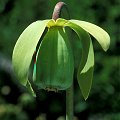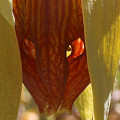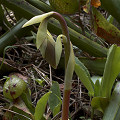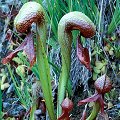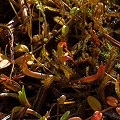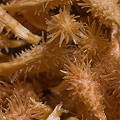Q: Darlingtonia: cultivation
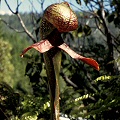 A: In most aspects, Darlingtonia cultivation is very easy.
Unfortunately, there are also a few key aspects in which Darlingtonia cultivation is very difficult.
If you mess up on the key aspects, your plants will die. In a perverse
inversion of how people usually talk about Darlingtonia cultivation, I will talk about
the easy stuff first.
A: In most aspects, Darlingtonia cultivation is very easy.
Unfortunately, there are also a few key aspects in which Darlingtonia cultivation is very difficult.
If you mess up on the key aspects, your plants will die. In a perverse
inversion of how people usually talk about Darlingtonia cultivation, I will talk about
the easy stuff first.
A light, well drained soil mix is best. Those with the most success use either pure live Sphagnum or
a Sphagnum:aggregate mix (the aggregate usually being pumice, perlite, or gravel). Although
Darlingtonia grows in soils rich with serpentine, it seems that serpentine does not need to be
added to the soil mix. Probably the serpentine is only useful in suppressing the growth of competing plants (serpentine is toxic
to many plants).
Watering Darlingtonia is best done from above. Do not fertilize them. These plants love light so give
them every damn photon you can. Protect them from frosts during the growing season and excessive temperatures
(more about that shortly). During the
winter, they go dormant. Plants from coastal regions do not seem to require much in the way of winter dormancy, but plants
from very snowy areas (such as the anthocyanin-free Darlingtonia 'Othello')
probably are more demanding in this respect. I have never had luck with them, certainly!
Propagation can be done by seed (they can be either selfed or crossed). Seed should be stratified for about four weeks.
Vegetatively, the plant can be multiplied by natural division, or when the plant produces a daughter
plant on the tip of a meter-long stolon. By the way, such underground stolons are not known to be produced by any other species in
the Sarraceniaceae, although this is a trick that some species of Heliamphora may be hiding
from us.
Now, all this suggests that Darlingtonia should be easy to grow. Unfortunately, only the lucky few
can grow it!
What happens, almost invariably, is that plants newly purchased for a collection die
within a year. If the plant is really large when it first arrives, within a year it becomes moderately sized. The next year
is is just small. The year after that it is tiny. Then it is dead. Or, despite the fact that a plant may languish in
cultivation for years, it may be only a few cm or so tall---as old as a two-year old plant in the wild would be. Why? Why
the high failure rate?
The conventional wisdom is that the plants want cool water running over their roots, or at least chilly
soil temperatures.
People have tried all sorts of tricks to achieve this, such as throwing purified-water ice cubes onto the soil on a daily basis, flushing
refrigerated water through the soil, creating circulating water benches, and so on. All this is
very difficult for people in warm climates, and I have never been successful cultivating it.
Fortunately for me, I live about two hours from a great Darlingtonia site,
so whenever I want to enjoy the plant I just take a small road trip. Nyah nyah nyah!
Oh, was that childish? Sorry.
I am not saying you cannot grow Darlingtonia---I have met lots of growers who can,
but they either
live in Darlingtonia country, or perhaps in cool parts of the San Francisco area, or chilly sites
in the UK, or have expensive climate-controlled greenhouses lousy with Heliamphora and highland
Nepenthes. It can be done. On the other hand, I have never seen cultivated
Darlingtonia that look as nice as wild plants. They just do not have the color. We know how to
grow Sarracenia and to a lesser degree Heliamphora, but we just have
not yet figured out Darlingtonia.
What is really horrific about this is that the nursery trade has found a clone of Darlingtonia that
performs well in tissue culture, and which propagates faster than roaches in a brothel. The nursery trade then packages the
little plantlets in tiny plastic terraria with brightly colored labelling and sells them to kids visiting nurseries, grocery
stores, and other venues. The plants may live for a few months (as tissue culture plants invariably have extra vigor), but then
descend in health and die. Hearts are broken. As I said before, so often the growers were children. It is cruel and sick,
really. It also contributes to the impression that all carnivorous plants are hard to grow.
Plants from the wild rarely adapt well in cultivation. Most suffer so much damage in the transplanting process that they die. I know
this because for several years, botanists on field trips would kindly bring unwanted specimens of such plants to collections I
managed for the University of California. The plants would always look good upon arrival, and would always
die even faster than plants from cultivated sources.
As a final note, I present for you a contraption that I call a Darlingtonia cooling box.
If you are really interested in growing Darlingtonia and do not live in a cool climate, you
might do well to read about the cooling box in the FAQ library.
Page citations: Rice, B.A. 2006a;
Rondeau, J.H. 1991; personal observations.

